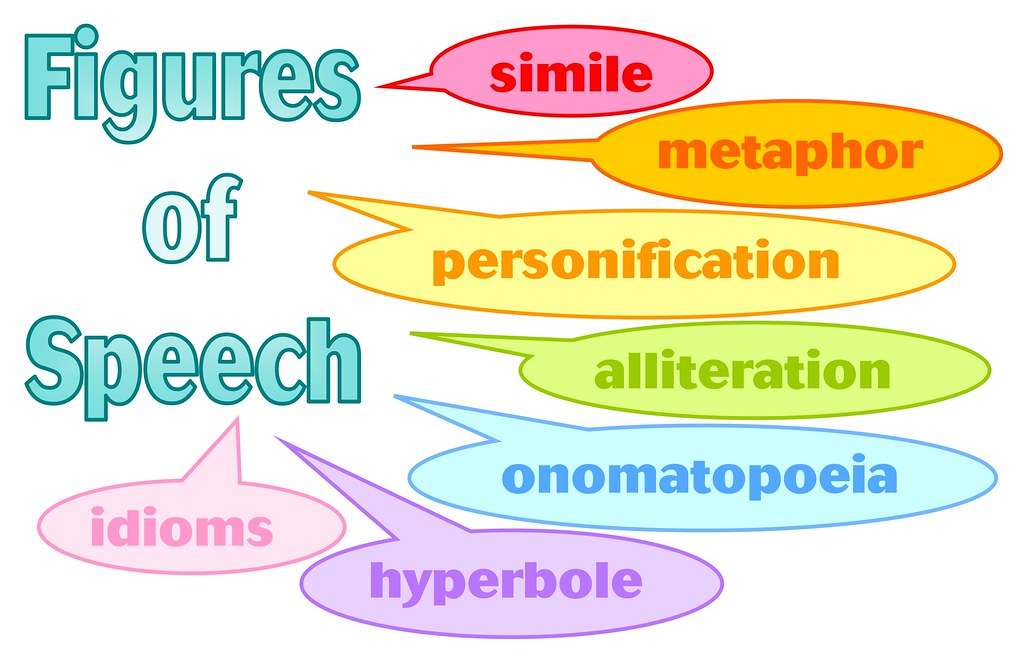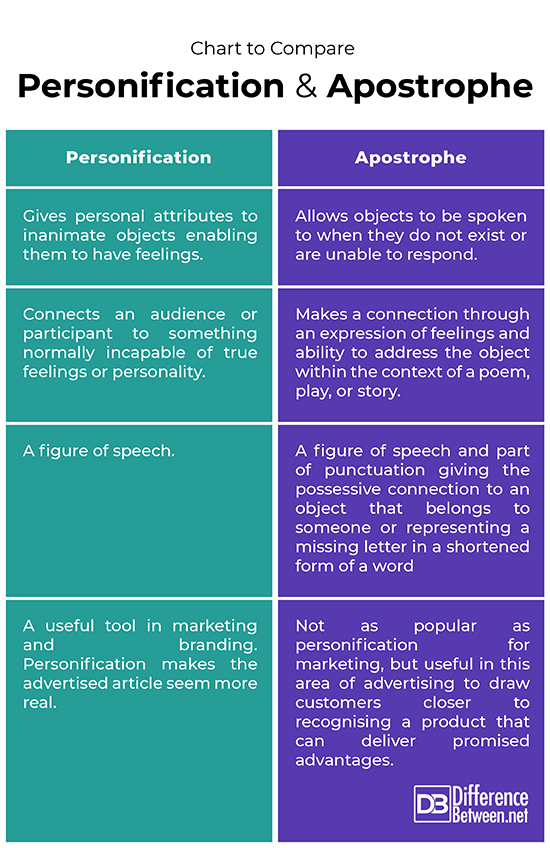Difference Between Personification and Apostrophe
Personification and apostrophe are both figures of speech. They appear in our everyday conversation and they are found in poetic and descriptive writing. Personification and apostrophe often refer to inanimate objects in a personal way. The words for these objects are given attributes they would not necessarily be able to manifest. The difference lies in the manner in which they are used. Personification refers to an inanimate object being able to have and show human characteristics and emotion. The apostrophe comes into human drama through someone addressing something that is not alive or capable of responding, but they are spoken to as if they do understand. Written examples of these two types of figurative language will help with understanding how they are used.

Understanding personification?
Personification is giving personal human qualities to inanimate objects. The object is spoken of as if it was human and had feelings or could possess human characteristics. It is a very creative device used by writers and poets. Personification stretches the imagination and is particularly useful in children’s literature adding more illustration through words to the text.
Examples of personification.
These examples of personification are taken from everyday language as we see them used to put emphasis on frustrations and appreciations of everyday things.
- My computer is not cooperating with me today.
- The school bell yelled loudly to get our attention this morning.
- I like chillies, but they do not like me.
- The trailer groaned when it was loaded with potatoes.
Personification is used extensively in creative writing. It draws the reader into the scene or the descriptive parts of the story.
- The young girl’s heart danced as the hero walked into the room.
- The wind whispered through the trees.
- The baby’s eyes smiled up at his mother.
Personification is used in some well-known literary classics, poetry and in children’s rhymes.
- Mother Goose Rhymes talk about ‘the dish that ran away with the spoon.’
- The Giving Tree, written by Shel Silverstein, tells us ‘Once there was a tree and she loved the little boy.’ The tree is personified to be capable of love for a little boy.

Understanding the apostrophe?
The apostrophe, as a figure of speech, makes use of words to converse with something that is not existent or is dead or inanimate. Through the use of this figure of speech, the apostrophe, a non-existent person or abstract idea can be addressed as if they are able to understand feelings. William Shakespeare made great use of the apostrophe, particularly in plays like Macbeth. Classical poetry is full of examples of the use of apostrophe as this form of figure of speech adds poetic language and examples of romantic thoughts and creativity. The apostrophe, as a figure of speech, used in creative writing should not be confused with the apostrophe or punctuation mark used to denote personal possession. The reader will often know an apostrophe is about to start in a poem or dialogue because the first word or exclamation will introduce the idea. The sentence or phrase will start with ‘O’ or ‘Oh’ and this is a sign that the speaker in the story, or poem, is speaking to someone or something they cannot see.
The famous poem ‘O Captain! My Captain,’ written by Walt Whitman is a great example of using apostrophe. The speaker says:
“‘O Captain! My Captain our fearful trip is done,”
In the poem the poet, Walt Whitman is actually referring to the death of Abraham Lincoln.
Examples of apostrophe.
Shakespeare has to be quoted as one of the most well-known writers who used apostrophe to dramatize events in his plays. We see Lady Macbeth calling on the night to come and hide her actions.
“Come thick night,
And pall thee in the dunnest smoke of hell,
That my keen knife, see not the wound it makes.”
In this well-known quote from Romeo and Juliet Shakespeare uses another apostrophe as he says:
“Arise fair sun, and kill the envious moon.”
The dramatic use of the apostrophe, as a figurative literary device, is very clear in these examples of writing and many others used by Shakespeare.
Mary Shelley uses apostrophe in her novel Frankinstein.
“Oh! Stars and clouds and winds, ye are all about to mock me; if ye really pity me, crush sensation and memory; let me become as naught; but if not depart, depart and leave me in darkness.”
What is the purpose of figurative language, especially personification and apostrophe?
Understanding figurative language helps with seeing how it is used to create images and take ordinary language beyond its literal sense into more creative and abstract usage. Personification describes objects in a way that people can relate to because it highlights the human qualities. Apostrophe gives the creative writer a way to address objects within a piece of writing, on a personal level, that they would not have been able to do before.
In this article explaining the difference between personification and apostrophe, two types of figurative language are discussed. The apostrophe therefore, has only been compared in its figurative manner, and not as a punctuation mark. Apostrophe punctuates words giving them a personal possessive quality and the apostrophe mark denotes a missing letter in some cases, but this function does not have a connection to figurative language.
Modern day uses of personification and apostrophe.
Personification, and apostrophe, are great tools and in today’s competitive market place. They are used to personalise a brand making it more appealing to the public. Personification in brand marketing builds the human tone and is the best way to start to see the brand in a positive light. Personally branding a product brings about interaction between a consumer and the product. It makes people think about brands as if they had character and personality. In today’s world of technology a brand that appears to talk or connect with its customers is far more appealing. Social media has opened doors towards more communication with products on a personal level.
In the commercial world it has become a marketing skill to personalise your product. Can you ‘talk’ to the brand and can the brand ‘talk’ to you? That is a measure of apostrophe because, through the personal message of the brand, it has the ability to interact with customers. Advertising asks people to think about the brand as if it were a person. Brand personality has five personality traits known as the five dimensions of brand personality. These traits are excitement, competence, sophistication, sincerity and ruggedness. The brand, through the apostrophe or personification, makes a promise to the customers. For example, Disney promises magical happiness and many other brands aim to create their personality through the brand dynamic and its attributes.
Chart to compare Personification and Apostrophe:

Summary of the Difference between Personification and Apostrophe.
- There is a similarity between these two figures of speech. They are both used in a way that brings human qualities to inanimate objects. Personification is used on a more personal character level. Apostrophe on the other hand is used to create a communication between something that no longer exists and something that cannot possibly communicate.
- These figures of speech add value to poetry and prose as they help to bring descriptive passages to life.
- Personification comes more naturally into our everyday conversation. Personification comes into expressions about the weather e may sayand other daily aspects of our lives. For example we may say things like – the wind is howling or the sun is smiling.
- Classical writers, like William Shakespeare, used both personification and apostrophe in his plays. There are several scenes where Shakespeare has heroes speaking to skulls and other objects that would never be able to interact with people and yet the person in the play speaks to these deceased objects.
- Personification and apostrophe have a part to play in modern day branding and advertising as they help large and small companies to market their goods through giving them relatable personal touches.
- Difference Between Lagoon and Bay - October 20, 2021
- Difference Between Futurism and Preterism - August 12, 2021
- Difference Between Dichotomy and Paradox - August 7, 2021
Search DifferenceBetween.net :
Leave a Response
References :
[0]Brinks Melissa. 01/03/2019. www.prepschooler.com. Online guides and tips. Personification, examples in poetry and literature and more. Pub. Prepschooler.com
[1]Nordquist Richard. 20/05/2018. www.thoughtco.com Figures of Speech, the Apostrophe and other literary devices. Pub. Dotdash publishing family.
[2]Loomis Coralyn. 18/05/2016. www.marketingprojs.com. Brand personification. Pub. Marketing proofs LLO.
[3]Image credit: https://commons.wikimedia.org/wiki/File:Image_of_carets_telling_reader_to_insert_a_comma,_an_apostrophe,_and_quotation_marks.png
[4]Image credit: https://live.staticflickr.com/6061/6124465150_e01e8edf1a_b.jpg
